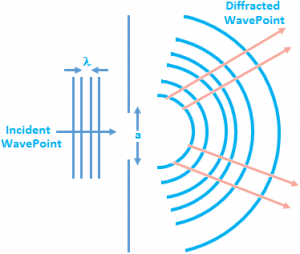Diffraction
The waves are travelling from more dense to a less dense medium. These are not stopped till these are reached at the end of the medium. The term reflection, diffraction and refraction are very similar to each other. Reflection is the process that includes the alteration in direction of waves when the wave is bounced off from the edge of the barrier while refraction of wave involves a change in the direction of waves when the wave is travelling from one medium to another medium.
The diffraction is the process of change in the direction of waves when a wave is passed around a barrier in its travelled path. Diffraction can be detected by using small barriers in the path of water waves in a ripple tank. Here we are discussing about the process of diffraction, its different types with its single slit experiment. The amount of diffraction shows bends sharpness which depends on the wavelength. It increases with increasing wavelength.
Definition: Refraction is the bending of light or sound waves that moves from one medium to another and a change in speed is forced. Refraction creates optical phenomenon and illusions.

Refraction is the bending of light or sound waves that moves from one medium to another and a change in speed is forced. Refraction creates optical phenomenon and illusions.
The word diffraction is resulting from Latin word diffract us which refers to split to pieces. When waves meet barrier, they bend round boundaries of harms if dimensions of the barriers are equal to the wavelength of the waves. The perversion of waves more or less the boundaries of an obstacle is known as diffraction.
Types of diffraction: Diffraction phenomena can conveniently be divided into two groups. They are
- Fresnel Diffraction
- Fraunhofer Diffraction
Fresnel Diffraction: In the Fresnel class of diffraction, the source or the screen or both are at finite distances from the aperture or obstacle causing diffraction. In this case, the effect at a specific point on the screen due to the exposed incident wave front is considered and no modification is made by lenses and mirrors.
Fresnel Number: The Fresnel number F, name after the physicist Agustin-Jean Fresnel, and is a dimensionless number attractive place in optics, in thorough in diffraction theory.
For an electromagnetic wave passing through an opening and hitting a screen, the Fresnel number F is defined as \(F\,=\,\frac{{{a}^{2}}}{L\lambda }\).
Where,
a – The point size of the aperture
L – The distance of the screen from the aperture
λ – The incident wavelength.
Fraunhofer Diffraction: When light from a far of distance falls on the edge then the plane wave fronts is seen on the screen. The source and screen are at infinite distance while the pattern is observed. Lenses are used to observe the pattern.
Fraunhofer diffraction is also called far – field diffraction, this diffraction occurs when an aperture is passed from the field waves, called wave diffraction. In the aperture, to change the size of an observed aperture images the slit causing due to the far-field location of observation. The Fraunhofer diffraction occur when F<<1, the shape and size of observed aperture image will be affected.
Fraunhofer diffraction is based on the principle of Huygens – Fresnel, when the waves passes through an aperture, the wave’s splits into numerous outgoing slit or hole. Fresnel diffractions are calculated by calculating wavelength λ, slit size and distance from the aperture L. Fraunhofer diffraction occurs by increasing the distance or wavelength due to the extent of diffracting objects.
Fraunhofer Diffraction is given as \(F\,=\,\frac{{{a}^{2}}}{L\lambda }\,<<1\).
